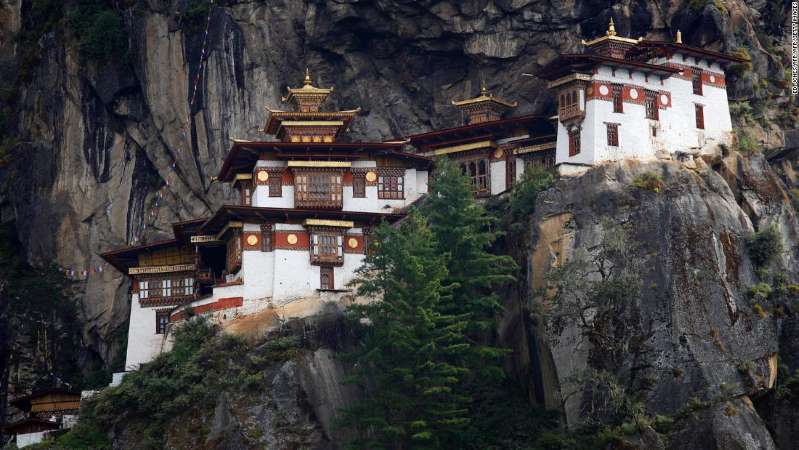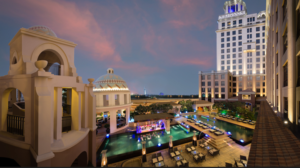Best places in Asia to visit for your next holiday

By Kate Springer, CNN
Two centuries ago, trips to Asia were reserved for wealthy merchants, ambassadors and colonial elite who could afford grand and expensive voyages. But that travel scenario has been turned on its head.
With a proliferation of affordable flights, versatile accommodations, high-speed rails and increased international connectivity, it’s easier than ever to visit Asia.
Why go? The world’s biggest continent has long captivated travelers with its natural beauty, distinct cultural traditions, ancient architecture and absolutely delicious food.
Here are 17 of Asia’s best destinations — a diverse mix of cities, islands and entire countries — to consider for your next adventure.
Bhutan
Anchoring the eastern end of the Himalayas, Bhutan showcases the very best of mother nature — picture dense forests, deep valleys and cloud-piercing peaks.
Travelers typically land in Paro, home to the country’s only international airport. The historic town is nestled in a verdant valley, surrounded by ancient Buddhist temples and monasteries.
The most notable is Paro Taktsang (also known as Tiger’s Nest Monastery), a sacred site that seems to cling to a cliff in the upper Paro Valley.
Aglow with white facades, gold-plated domes and rust-red accents, the 17th-century temple sits alongside a cave network, known as a sacred meditation site.
The steep, two-hour pilgrimage to the monastery is challenging, but the payoff is unforgettable.
Penang, Malaysia
Located off the western coast of Malaysia, the island of Penang is a mecca for food and architecture lovers.
George Town, the island’s main city, makes for an ideal home base thanks to a dynamic cityscape that’s punctuated by British colonial architecture, Buddhist temples and ornate Chinese manor houses.
This seaside city is known as one of the world’s top food destinations, serving up a delicious mix of Malay, Chinese and Indian cuisine.
You’ll crave dishes like Hokkien mee (fried prawn noodles), roti canai (an Indian-influenced flat bread dish with dal or curry) and Penang laksa for years after visiting.
El Nido, Philippines
Searching for tropical paradise? You’ll find it in El Nido. Located on the northern tip of Palawan Island, in the southwestern Philippines, the archipelago plays host to turquoise waters, mysterious lagoons, dozens of beaches and secret caves.
Surrounded by dramatic limestone cliffs, Bacuit Bay is the crown jewel. It’s here where you can explore the mysterious lagoons via nimble kayaks.
Travelers spend their days snorkeling and diving, or cruising around remote and hidden beaches across the archipelago.
Many tour operators arrange adventure-packed boating trips, complete with grilled seafood lunches served on board.
Bali, Indonesia
Beautiful Bali, Asia’s most famous wellness getaway, sits in the center of Indonesia’s vast archipelago. Of the country’s 18,000-some islands, Bali is easily the most famous, drawing more than 5.6 million foreign visitors every year.
Even amid the popularity, the island oozes relaxation and a sense of spirituality. It can be felt across the territory — in the imposing cliffs in Uluwatu, tranquil waves in Nusa Dua, trendy beach clubs in Seminyak and dramatic rice paddies and temples in Ubud.
For those who love an adventure, the island’s mountain trails and secret coves will showcase a more remote side of this well-trodden paradise.
Then there’s the food: from healthy juice bars to beachfront seafood barbecues, the dining scene will spoil you for choice.
Seoul, South Korea
Seoul might have a well-deserved reputation as one of Asia’s more futuristic cities, but the capital of South Korea is also home to a wealth of ancient landmarks that provide a peek into the past.
There’s the sprawling Gyeongbok Palace, Changdeok Palace, Deoksu Palace and elegant hanok (traditional wooden homes), just to name a few.
After exploring the city’s imperial history, travelers can get a sense of what makes modern Seoul tick in upbeat neighborhoods like Hongdae.
As the creative heart of Seoul, this is where you’ll find popular K-beauty boutiques, restaurants, bars, street performers, karaoke and an endless array of clubs.
Rajasthan, India
An arid desert region in northwestern India, Rajasthan has long been considered the land of kings and colors.
Most first-time travelers trace the rainbow through the regal region, starting with Jaipur, aka the “Pink City.”
So named for its salmon-hued buildings of the Old City, Jaipur showcases Rajasthan at its best: ornate palaces, buzzing bazaars and the UNESCO-listed Amber Fort.
A deeper dive will take you to Jodhpur (the Blue City), Udaipur (the Gold City) and Ranthambore Tiger Reserve, where Royal Bengal Tigers rule the land.
Siem Reap, Cambodia
Over 2.5 million tourists descend on the city of Siem Reap in Cambodia every year with a common purpose: to see Angkor Wat.
Dating to the 12th century, this UNESCO-listed Khmer temple, part of the massive Angkor complex, is a staple on every bucket list for good reason.
The incredible architecture features distinct towers, intricate carvings and stone corridors that feel cool underfoot.
And within the Angkor Archaeological Park, you’ll also find two other major temples — Angkor Thom and the Bayon Temple — all surrounded by dense jungle.
After seeing the sites, travelers will want to explore Siem Reap’s chic restaurant scene or head farther afield to less-frequented temples.
A few worthy side trips include Banteay Srei (nicknamed the “Pink Temple” for its sandstone structure) or 12th-century Beng Mealea where encroaching foliage and vines create an eerie, mysterious atmosphere.
Hong Kong
A former British colony with deep Cantonese roots, Hong Kong embodies the urban jungle archetype.
The architectural density, narrow city streets, soaring skyscrapers and fast-paced way of life set the tone for an action-packed visit.
Victoria Harbour flows through it all. The famed Star Ferry cruises across the jade green water — a peaceful scene that’s starred on many a postcard.
Hong Kong’s cosmopolitan charms reveal themselves in Central, where glamorous bars, restaurants and art galleries await.
And across the harbor, Tsim Sha Tsui’s museums and mega malls boggle the mind. Meanwhile, more traditional districts such as Yau Ma Tei and Sham Shui Po showcase mom-and-pops cha chaan teng (post-World War II diners) and lively outdoor markets.
No matter which district you explore in Hong Kong, there’s always something new to uncover — whether it be hidden down an alley or up inside a commercial tower.
Hanoi and Phu Quoc, Vietnam
As the capital of Vietnam, Hanoi is a hub of history, culture and endless energy.
For first-time travelers, the Old Quarter is the best place to start. This labyrinth of lanes reveals French colonial architecture, hardworking hawkers, artisanal crafts and no shortage of restaurants.It’s busy and chaotic but navigating the crowded streets, where motorbikes reign, is half the fun.
After soaking up the history of Hanoi, travelers can chase the sun to Phu Quoc.
The 28-island district, located off the coast of Cambodia but still part of Vietnam, is home to some of the most beautiful beaches in Southeast Asia — not to mention the world’s longest oversea cable car.
Whether you stay on more developed Phu Quoc Island or ultra-remote Hon Xuong, the region promises island hopping, snorkeling, diving, sandy shores and more.
The Great Wall and Xi’an, China
A remarkable feat of engineering, The Great Wall is a must-see when in China.
Stretching for anywhere from 1,500 to 13,000 miles (estimates vary), the fortified wall runs across northwestern China like an stony spine.
While carefully restored areas like Mutianyu make for an easy stroll, forgotten stretches like Jiankou feel wild and steep.
The latter provides an unforgettable adventure across crumbling corners and overgrown watchtowers, but it’s more suitable for experienced hikers.
Continuing the historic tour of China, Xi’an is another highlight. Southwest of Beijing, this ancient city once played host to merchants, poets and warriors in the heyday of the Silk Road.
You can cycle atop the city’s beautiful Ming-era city walls, explore the leafy lanes of the Muslim Quarter and experience the famed Terracotta Warriors.
As one of the world’s most revered archeological sites, the lifelike stone warriors serve as guardians of the tomb of Emperor Qin Shi Huang, the founder of the Qin dynasty.
Chiang Rai, Thailand
Located near the Golden Triangle (at the confluence of Thailand, Myanmar and Laos) in northern Thailand, the city of Chiang Rai is often overshadowed by its neighbor, Chiang Mai.
But for those who appreciate unspoiled natural scenery and a slow-paced lifestyle, the atmosphere is just right.
Among the highlights around town, the ornate Blue Temple and 14th-century Wat Phra Kaew temple showcase historic Lanna architecture, while photogenic Wat Rong Khun (aka the “White Temple”) serves as a modern gem.
The blinding white facade is covered in glittering mirrored chips, while unexpected contemporary artwork lines the interiors.
Chiang Rai also draws travelers to sample its northern style of Thai food, best enjoyed at no-frills local restaurants and markets.
Staples include ubiquitous grilled pork sausages, khao soi (northern noodle curry) and gaeng hung lay (pork curry with ginger), but there’s a whole world of food to explore.
Luang Prabang, Laos
It’s hard not to fall in love Luang Prabang. Surrounded by mountains, the UNESCO-protected ancient capital of the Lan Xang Kingdom feeds the soul both figuratively and literally.
You’ll be surrounded by sacred rivers and golden wats, robed monks and silent meditation — an ideal getaway for those who need to unplug.
And then there’s the food. Laotian cuisine is famously fresh and excellent, drawing largely from local produce and ingredients.
The most popular dishes include fish or pork laap (akin to a spicy meat salad), khao jee pa-tay (banh mi-style sandwiches), paeng pet (spicy fried duck meat mixed with blood, organs, and herbs), herb-stuffed sausages and buffalo jerky.
Kathmandu, Nepal
As the most likely starting point on an adventure through Nepal, Kathmandu captivates travelers from the moment they touch down.
The labyrinth of little lanes, kaleidoscopic bazaars, speeding rickshaws, the scent of simmering chilies… it’s a sensory experience like no other.
In the center of it all is Durbar Square, a UNESCO-listed palace complex that marks the heart of Old Town and serves as an extraordinary example of Nepal’s traditional architecture.
All the while, the mighty Himalayas loom in the distance. With Kathmandu as a base, you can tackle various trails, including the one-day Champadevi Hill hike which weaves through a pine forest toward a spectacular summer.
For something more intense, the five-day Shivapuri circuit traverses the namesake national park (famed for its diverse flora and fauna) and rewards travelers with excellent views of the Himalayas.
Yogyakarta, Indonesia
While Bali might be Indonesia’s go-to beach destination, Yogyakarta lures history enthusiasts from all over the world.
Located on the island of Java, this ancient city is considered the cultural capital of Indonesia thanks to its vibrant art scene, indie boutiques, deep-rooted rituals and religious sites.
This is where you’ll find two of the country’s most important UNESCO-listed archaeological sites: Prambanan and the Borobudur temples.
Built in the 9th century, beautiful Borobudur is said to the largest Buddhist temple in the world and is particularly majestic at sunrise. Meanwhile, imposing Prambanan features ornate spires and Hindu architectural elements.
As a long-standing tradition, Prambanan hosts nightly Ramayana ballet performances — an unforgettable dance-drama that taps into the roots of Javanese culture — that are both enriching and entertaining.
Kyoto, Japan
Tokyo might be the commercial heart of Japan, but Kyoto embodies its heritage. The city is home to no less than 1,600 temples and 17 UNESCO sites, not to mention postcard-worthy scenes everywhere you go.
Most notably, the traditional district of Gion is where you’ll find kimono-clad geishas strolling across bridges, while chefs meticulously prepare multi-course kaiseki meals. It’s not a movie — it’s real life.
Exploring the city’s various temples could takes weeks, months, years…. But if you’re here for the highlight reel, must-visit landmarks include Nanzen-ji Temple, Fushimi-Inari-Taisha Shrine and Kinkaku-ji (the “Golden Pavilion”) — all promise beautiful gardens and traditional architecture.
Elsewhere in the city, the mystical Sagano Bamboo Forest draws its fair share of visitors, as does the 8th-century Fushimi Inari Shrine atop Mount Inari, famed for its photogenic orange torii gates.
Sri Lanka
This teardrop-shaped island nation can be found off the southeast coast of India.
Despite its urban sprawl, capital Colombo feels slow-paced and approachable thanks to its colonial architecture, wide streets and serene Buddhist temples.
From there, most travelers head south to the colonial fort of Galle, which feels like a walled village on the coast, before tracing the southern coastline for whale watching, powdery sand beaches and perhaps an elephant safari in Uda Walawe National Park.
Then it’s up into the cool highlands, where winding roads zig through lush tea plantations and old British hilltowns, like Nuwara Eliya.
Up north, you’ll find what’s dubbed the Cultural Triangle for its ancient and natural wonders, including the iconic Sigiriya Rock — a former palace-fortress built atop a dramatic rock plateau — the Dambulla cave temples, and the beautiful imperial city of Kandy, just to name a few.
Maldives
Remote and romantic, the Maldives is a top choice for honeymooners for a reason. Set off in the Indian Ocean, the 1,929-island archipelago is home to consistently tropical weather with temperatures hovering around 86 degrees Fahrenheit (30 degrees Celsius) throughout the year, though it’s best to avoid monsoon season from June to August.
It’s the kind of place where you can relax, unwind and tune out the world for as long as you like. Or you can snorkel and dive, surf and island hop — the experience is totally up to you.
But it would be a shame if you missed the rich marine life. In particular, areas like Hanifaru Bay and the Blue Hole, both in the northerly Baa Atoll, are known for incredible visibility and cyan water that’s teeming with manta rays, whale sharks, turtles, and colorful reef fish.
Image: Paro Taktsang- also known as Tiger’s Nest Monastery is one of Bhutan’s most famous sites./Getty
Source: cnn.com
June 3 , 2019












